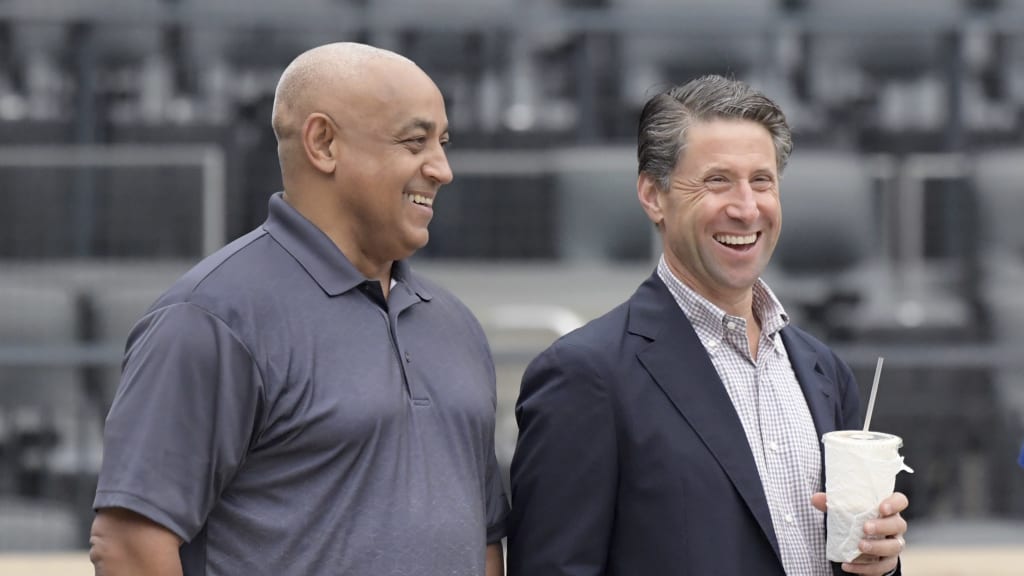
When Omar Minaya speaks, the Mets still listen.
The well-traveled executive, who served as the team's general manager from 2004-10, returned for his third stint in the franchise’s front office in '17 as a special assistant to his successor, Sandy Alderson. In that role, he was valued primarily for his scouting expertise. But the offseason hiring of Brodie Van Wagenen -- a former player agent with no previous front-office experience -- as the team’s new GM has amplified Minaya’s voice.
As Van Wagenen puts it, Minaya, still working under the title of special assistant, is part of a “leadership group” that is involved “in every aspect of our roster building, every aspect of our player evaluation and every aspect of what we’re doing in building our infrastructure.”
As such, Minaya participated in the internal discussions that produced the Mets’ offseason moves, which included trading for Robinson Cano and Edwin Diaz, and signing Jeurys Familia, Wilson Ramos and Jed Lowrie as free agents. All the while, he has remained a central figure for the team on the international scouting front.
Minaya says he is satisfied with his multifaceted role and the level of influence it affords him.
“It offers a lot of versatility,” Minaya said in Spanish. “And I like that, because I have the flexibility to do different things and help not only with the big-league club, but with developing and improving the farm system.”
Minaya, 60, was heavily involved in the Mets' most crucial offseason decision of all -- the hiring of Van Wagenen himself. Having worked for the Major League Baseball Players Association as an advisor prior to returning to the Mets, Minaya was familiar with Van Wagenen, and green-lighted the hire with enthusiasm.
“He knows the business. He knows the market. It was very valid,” Minaya says. “Although he had never worked for a team, I thought he was someone who could do this job, especially with support from people like myself.”
Mets COO Jeff Wilpon goes as far as saying that Minaya’s presence made it possible for the organization to think outside the box and hire someone like Van Wagenen.
“Part of hiring Brodie was knowing that I had Omar here,” said Wilpon. “The things that I’ve learned from Omar over the years and the friendship we have and the working relationship we have is amazing. He’s here to help everybody in the organization, top to bottom. You can never ask Omar to do something and he’ll say no.
“He’s a great asset for us to have, and certainly for Brodie as well -- having been a former GM, having been with the Players Association; having been here in New York, even more importantly.”
Diversity of experience
Since taking on the Mets’ GM job in late October, Van Wagenen has remodeled the front office as aggressively as he has the roster. Former Mets David Wright, John Franco and Al Leiter have all joined Van Wagenen’s cabinet as advisors, as has ESPN baseball analyst and Olympic softball gold medalist Jessica Mendoza. Former manager Terry Collins is still around, too. Yet Minaya’s diversity of experience stands out.
Drafted by the Athletics in 1978 out of Newtown High School in Queens, Minaya toiled briefly in Oakland’s and Seattle’s minor league systems, and also played in Italy. Between 1985-97, he made a name for himself as a scout for the Texas Rangers, rising to director of professional and international scouting.
Minaya left Texas to join the Mets as senior assistant GM, overseeing the team’s international scouting department. In 2002, he was named GM of the Montreal Expos at a time when the franchise was owned by MLB. He was the first Hispanic to hold that title with a Major League club.
Minaya returned to the Mets as the GM prior to the 2005 season. After being dismissed following the '10 campaign, he became vice president of baseball operations for the San Diego Padres, and was later a senior advisor to MLBPA executive director Tony Clark.
Former Rangers GM Tom Grieve, once Minaya’s boss, believes it’s that breadth of experience that makes him a valuable addition to the Mets’ front office.
“You’re not going to find a guy who is as well-rounded, and been as many places and done as many things as Omar,” said Grieve, who has been a broadcaster for the Rangers since 1995, by phone. “So it’s kind of like one-stop shopping. You can hire three or four guys to cover all those areas or you can hire Omar. ... Every facet of a baseball organization that you might need input or advice on, he’s been there and done it.”
Grieve, dismissed by Texas in 1994, recalls being asked to stay in the Rangers’ front office as an advisor to his successor, Doug Melvin. Grieve turned down the offer because he didn’t believe the new regime would value his opinion. Given Minaya’s level of influence on the Mets, however, it doesn’t surprise Grieve that the former GM would be content in an auxiliary role.
“I would have been willing to do that under the right circumstances, where people would value my input and I’d be an important part of organization,” said Grieve.
“For a new guy coming in, to be able to lean on [Minaya] for virtually any question he could possibly have, on the field, off the field, I think it’s like a dream. ... for Brodie. To me, it’s like a coup. ... If Omar says he’s comfortable with that job and wants to do that job, I’d take him at his word.”
Silver linings
The Mets’ decision to hire Minaya as an assistant to Alderson in December 2017 raised more than a few eyebrows around baseball because of its potential for awkwardness. Things only got more unorthodox from there.
After Alderson who took a leave of absence in July due to a recurrence of cancer -- he ultimately stepped down -- the team split the interim GM duties among Minaya, special assistant J.P. Ricciardi and assistant general manager John Ricco. (Ricciardi has since joined the San Francisco Giants, while Ricco was reassigned within the Mets' front office.)
Though there was some speculation that Minaya was an early candidate to replace Alderson, Minaya maintains that he was never interested in reprising his role as GM.
“I was already the GM once. I believe it’s time for someone else to do that job,” he said.
The Minaya years in Queens were defined by peaks and valleys. Minaya was aggressive in his first winter on the job, signing superstars Pedro Martinez and Carlos Beltran to free-agent contracts. Prior to the 2006 season, he acquired slugger Carlos Delgado, who helped the Mets win the National League East, although they fell a win short of the World Series, after dropping Game 7 of the NL Championship Series to the Cardinals, which ended with Beltran’s infamous caught-looking strikeout on an Adam Wainwright curveball.
The heartbreak of two subsequent September collapses still haunts the fan base. And while it was Minaya who engineered the trade with the Twins for two-time American League Cy Young Award winner Johan Santana, he was also behind the failed free-agent signings of Jason Bay and others. Controversies within the front office, and in dealings with the media, cast further shadows on Minaya’s tenure.
Yet Minaya says he is able to look beyond the shortcomings to find silver linings. His New York pride -- he was born in the Dominican Republic but moved to Corona, Queens at 8 years old -- is evident when he notes that in 2008, the last season the Mets played at Shea Stadium, team attendance surpassed four million. They had never drawn that many fans before and have not since.
“You play to win,” said Minaya. “But if you don’t, there are other accomplishments that come with participating.”
But if there’s any vindication of the Minaya era, it came in 2015, when an overachieving Mets team reached the World Series with a roster replete with homegrown players drafted or signed under Minaya’s watch, including 2018 NL Cy Young Award winner Jacob deGrom, Matt Harvey, Steven Matz, Jeurys Familia, Daniel Murphy, Lucas Duda, Juan Lagares, Wilmer Flores, Ruben Tejada, Jonathon Niese and Hansel Robles.
It was Minaya who took a gamble on veteran pitcher R.A. Dickey prior to the 2010 season. The knuckleballer went on to win the NL Cy Young Award in '12, and he was traded to Toronto that winter for Noah Syndergaard and Travis d’Arnaud.
Deflecting credit for the success of the 2015 Mets, Minaya says he was thrilled for the franchise and for the players, some of whom he’d known since they were teenagers.
“Playing in a World Series is a wonderful moment,” said Minaya. “For me it was an accomplishment -- not for me personally, but for the organization, the scouts, the development staff, the new administration and the owners. I was happy for the Mets’ organization and for New York."
For love of the game
Minaya frequently brings up his love of scouting, and it was his eye for identifying talent that got him a foot in the door with Texas during Grieve’s tenure as GM.
Grieve recalls Minaya so impressing Sandy Johnson that the former scouting director hired him as an amateur scout almost on the spot, despite his lack of experience. It turned out to be a smart move. Minaya went on to help Texas sign sluggers Sammy Sosa, Juan González and Hall of Fame catcher Ivan Rodriguez.
“I loved his enthusiasm. I loved the love for the game. He was bright, optimistic, positive,” said Grieve, who describes Minaya as a “risk-taker.” “So many times, you talk to scouts who, when they talk about a player, will give you all the reasons why he’s not going to be successful, all his negative attributes. Omar wasn’t that way. Omar always gave you why he thought this kid was going to be a good player. He would be honest about it if he didn’t think so. But I always liked the fact that his opinion of players accented the positive things that the kids had.”
Grieve also recalls Minaya being a vital resource for the Rangers’ young Latino players -- especially the Dominicans -- as they made the transition to life in the U.S. Minaya helped them find housing and made sure they ate properly.
“He knows what it takes to sign the players [in the Dominican],” said Grieve. “He’s seen the way that they adapt to our society, our culture, the problems that they might have doing that, and knows how to deal with that.”
Not surprisingly, Van Wagenen says Minaya will “be very much involved in all our international draft signings” as well with as nurturing talent at the Mets’ academy in the Dominican Republic.
“He loves to scout. He loves to identify players,” said Van Wagenen. “He has deep roots in the Latin American market, in particular in the Dominican Republic. So he’s going to be taking a leadership role in our efforts, both from a scouting standpoint as well as a player development standpoint in our academy.”
In what might be the most tangible indication of Minaya’s stature in the Mets’ international scouting efforts, some of the team’s recent hires in that area go back to the Minaya era -- Rafael Perez, who was the Mets’ director of international operations from 2005-11, has returned to that role, while Luis Marquez, a scout for New York from '08-11, is now the team’s director of international scouting.
“I think that when we look at the game, we see the big stars that come from the international arena,” said Minaya. “I like it. I love being involved and I think it’s important for this organization not only to be involved, but to be a leader in that area.”
